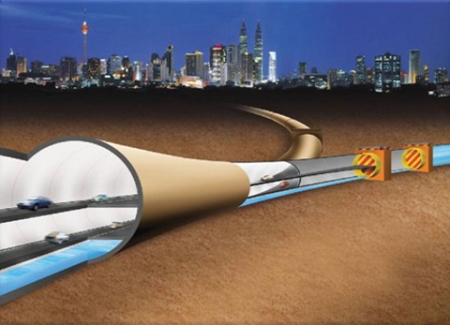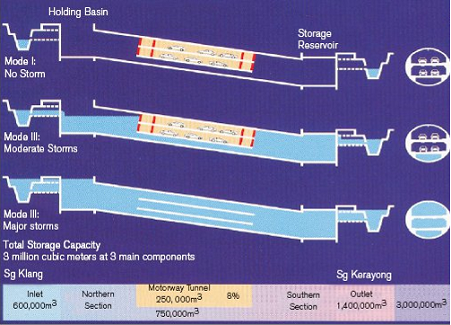
November 30, 2017, by lgzsam1
How are transport networks going to become more resilient to flood risk?
In this blog, Dr David Dawson examines flood risk on the physical transport network and some potential developments for improving urban flood risk by connecting multiple infrastructure systems.
Plumber, ‘Sorry Transport Secretary, you have a leak!’
Transport Secretary, ‘Well, how bad is it?’
The Issue
The extent of flood risk across our transport networks is relatively widespread. By cross referencing ‘known geological indicators’ of flood risk [1] with maps of the transport network we can make some initial estimates (Figure 1). This excludes surface water flood risk; Network Rail actually estimate that nearly 40% of its network is at a high to medium risk of flooding. Given the importance of mobility in our everyday lives, more frequent unexpected disruption could be problematic and potentially costly, thus investment in resilience and infrastructure adaptation is becoming a key agenda [2-4].
Figure 1: Transport networks located in areas with geological evidence of flood risk. A = strategic road network (motorways and A-roads), B = minor road network, C = rail network. The UK motorway and road network have around 15% of their networks in flood risk areas, whilst a quarter of the rail network is in an area of flood risk (excludes surface water flooding); or 506 km, 6557 km and 3889 km respectively. Rebuild costs can be up to £100 million/km for rail, or £14 million/lane/km on roads [5]. Hard engineered flood projection costs range from £0.5 – £11 million/km [6]. Source: [4]
Transport Secretary, ‘OK. So… how much will it cost me?’
Plumber, ‘Well… it’s not going to be cheap, I’m afraid.’
The Status Quo
Investment in ‘grey’ infrastructure (e.g. traditional hard structures, drainage pipes, concrete defences, etc.) on such a large scale would require billions of pounds of investment, and has the disadvantage of being a ‘fixed’ solution to a ‘dynamic’ problem. Furthermore, in the limitations of austerity, and in a culture where investment in large transport schemes are seemingly valued on the basis of the ‘cutting of the ribbon’ [7], investment in resilience is uncertain.
Transport Secretary, ‘Well that’s one option, isn’t there another?’
Plumber, ‘Potentially…’
An Alternative Solution?
In contrast, investment in blue-green infrastructure (e.g. that which mimics the environment: natural defences and sustainable drainage systems) offer an alternative, more flexible solution to flood prevention and provide wider benefits to both society and the environment [8-10], and could even be cheaper in the long term (given uncertainty in future trends). There are also innovative designs emerging that have designed new transport systems that can be operated as a storm water management systems across the globe (e.g. Figure 2). How these ideas/designs transpose to existing systems and the connection of more natural management chains remains an area of research interest.
Figure 2: Kuala Lumpur SMART Tunnel: two issues, one solution. Storm water management and road tunnel aiming to divert large volumes of floodwater from a critical area via a holding pond, bypass tunnel and storage reservoir [11].
Transport Secretary, ‘Surely, that’s the problem sorted.’
Plumber, ‘Not quite… and don’t call me Shirley!’*
*Reference to the motion picture Airplane (1980), for entertainment purposes only.
The uptake of more novel and interconnected approaches is being limited by the justification for investment, understanding of risk, and the inclusion of perceived wider benefits and value within existing frameworks [8]. If we are to address future urban flood risk there is a real need for co-ordinated, interdependent action on three fronts; hard infrastructure systems (e.g. our transport networks), sustainable solutions (blue/green infrastructure) and the assessment of adaptations into long-term investment plans.
As part of an EPSRC-funded urban flood risk project [12] we are investigating novel blue-green and grey systems and their potential to reduce urban flood risk and add value to our urban environments.
References
- BGS geological indicators of flooding, available from: http://www.bgs.ac.uk/products/hydrogeology/indicatorsOfFlooding.html
- Department for Transport (2014). Transport Resilience Review.
- Committee on Climate Change (2016) UK Climate Change Risk Assessment Evidence Report 2017.
- Dawson DA and Marsden G. (2018) Transport Disruption: New Realities? In: Shaw and Docherty (Eds.) Inside Track. Policy Press, London.
- HM Treasury (2010) Infrastructure Cost Review: Technical Report, December, London, 1-111
- Environment Agency (2015) Cost estimation for coastal protection – summary of evidence Report: SC080039/R7, Bristol, 1- 47
- Bauer, T (2015) http://thecontextofthings.com/2015/03/03/america–infrastructure–problem/
- HM Government (2016) National Flood Resilience Review, London.
- CIRIA (2007) Sustainable Urban Drainage Manual The SuDS Manual (C753),
- https://detroitography.com/2013/09/20/detroit-blue-green-infrastructure-map/
- http://smarttunnel.com.my/
- http://www.urbanfloodresilience.ac.uk/
Dr David Dawson is a Leverhulme Early Career Research Fellow at the University of Leeds. His research interests span infrastructure resilience, climate change adaptation and approaches to evaluating/valuing systems using non-standard techniques (e.g real options). He is currently part of the EPSRC-funded Urban Flood Resilience in an Uncertain Future project.
No comments yet, fill out a comment to be the first




Leave a Reply